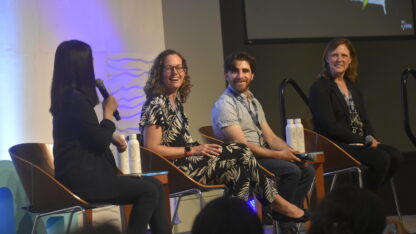Summer Science: Clothes Keep You Cool, More Or Less
The cool weather in London is good news for the Olympic athletes because their bodies won’t need to put as much energy into cooling off.
But most of us aren’t lucky enough to be headed to London, and we could use some help keeping cool.
When you get hot you sweat — but it’s not enough to just sweat. To cool off, you need that sweat to evaporate. It’s evaporation that drains the heat from your body.
To help the sweat evaporate, you want air to flow over your skin — as much of your skin as possible. So the best clothing for people to wear when exercising is none at all.
That’s according to George Havenith, a professor of environmental physiology and ergonomics at Loughborough University in Leicestershire, England.
“They would probably want to wear some underwear to just cover up and be comfortable in that way. But in terms of the heat loss, the naked person is best able to lose heat.”
That’s only if the sun’s not shining. If the sun’s out, you need clothing to protect your skin from burning.
“So then you have to find a balance with a certain amount of clothing coverage,” Havenith says, “without the clothing actually hampering the sweat
evaporation.”
But that made me wonder. Why wear clothes? Why not just wear sunscreen?
“Unfortunately sunscreen sometimes affects sweating,” Havenith said. “So the sunscreen then might reduce the amount of sweat evaporation or the amount of sweat production. So that’s where things again could go wrong.”
So if you’re exercising in the heat, wear as little as possible, especially after the sun goes down.
But if you’re not an Olympic track star, skimpy Spandex is not the way to go. Think light and loose. That’s because even if you don’t feel like you’re sweating, you still want to evaporate moisture off your skin. The loose clothing allows air to pass long the skin and exit, speeding evaporation and carrying off excess heat.
Another big question in the summer clothing world is color: dark or light?
Researchers have studied the heavy black robes worn by Bedouins in the desert. They say the key there is thickness. The outer layer of fabric does get hotter because the black color absorbs more heat. And that heat doesn’t get transmitted to the skin because of the thick fabric.
But thin black clothing transmits that heat to the skin, making a person hotter.
To sum up: Light-colored clothes in the summertime during the day, and get naked at night.
“I’ll leave that to you to be said,” Havenith said. “But in essence that’s probably quite the basics.”
9(MDAxODM0MDY4MDEyMTY4NDA3MzI3YjkzMw004))





